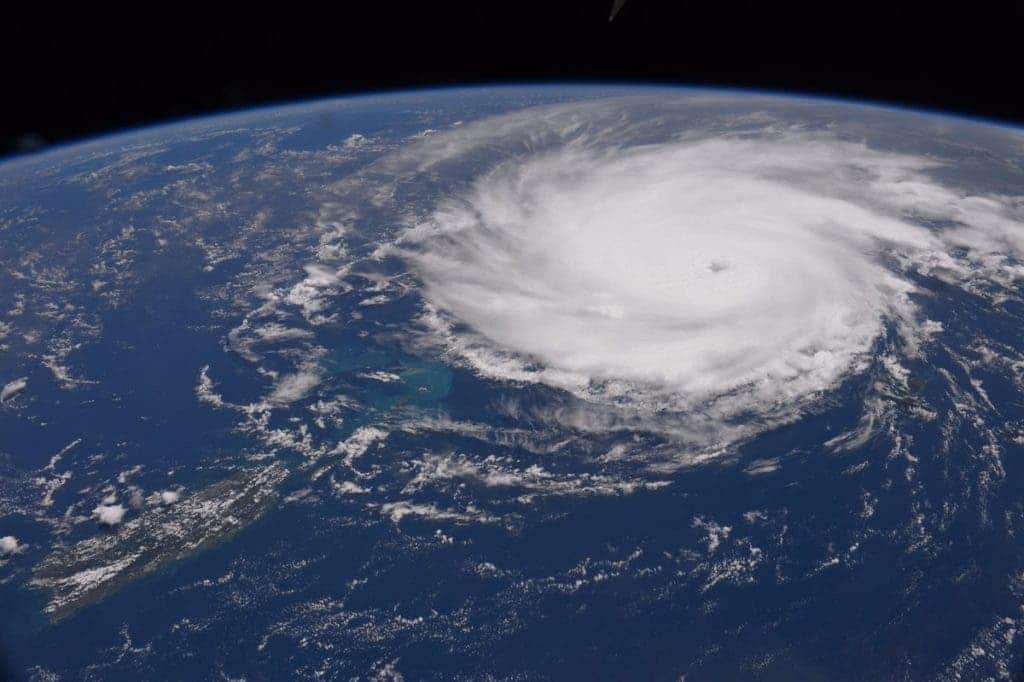Randy “Komrade” Bresnik, NASA’s ISS commander, has a pretty rad hobby: he takes photos of hurricanes, from outer space. It looks like this:
From the space station 260 miles (419 km) above Earth, Bresnik thoughtfully looks down every day, hoping that the hurricane season will cause no more pain and destruction. He shares photos not only of the hurricanes themselves, but also of the areas unfortunate enough to be in their wake. The island of Barbuda, for instance, was 90% destroyed. The Turks and Caicos Islands, a British Overseas Territory, were also directly hit.
What a difference a week makes, Turks and Caicos before and after #Irma. pic.twitter.com/BAm438TSwe
— Randy Bresnik (@AstroKomrade) September 10, 2017
A Texan himself, Bresnik started with photos of Harvey, lamenting the destruction the storm has brought in his hometown of Houston. Like much of America, Bresnik let go a sigh of release as Harvey finally left Texas, but warned against taking it lightly.
#Harvey – still a menace! Hearts & prayers go out to families, friends, & fellow Texans dealing with this storm. #TexasStrong #HoustonStrong pic.twitter.com/6E4otEWF6x
— Randy Bresnik (@AstroKomrade) August 28, 2017
Unfortunately, this hurricane season proved especially damaging and just as Harvey made its exit, Irma stepped in. To Bresnik, Irma seems more like a monster than a storm.
The tentacles of the bow wave of #Irma clawing its way up Florida…. pic.twitter.com/BKCS8RrCnB
— Randy Bresnik (@AstroKomrade) September 10, 2017
Irma became the strongest hurricane ever recorded in the Atlantic, with sustained winds of 185 miles per hour, and gusts going even faster. Irma was so strong it got picked up by seismographs, sensors built to detect earthquakes.
#Irma Massive! #Jose, not as massive but just as destructive to those reeling from the previous hit. pic.twitter.com/RYCTjmz4q4
— Randy Bresnik (@AstroKomrade) September 11, 2017
Irma claimed at least 12 lives, though the official toll might be much higher in reality. Florida Gov. Rick Scott said the storm left “devastation” on the Keys, but at this point, it’s unclear just how much damage Irma caused.
Then, meteorologists started issuing warnings for Jose.
The eye of #Jose, may it veer north and east away from those so affected by Irma’s wrath already. pic.twitter.com/g6RtKGx2CD
— Randy Bresnik (@AstroKomrade) September 10, 2017
Thankfully, Hurricane Jose seems to have dissipated much of its energy and steered clear of densely populated areas. Jose is now a Category 1 hurricane, unlike Irma which was a Category 5, the highest category on the scale.
But while a US impact is unlikely, it’s still possible — and other areas may yet be struck by the hurricane.
“Canada appears more likely than the U.S. to receive a hit from Jose at this point, but it is too early to be a believer in these long-range model forecasts,” said Weather Underground meteorologist Jeff Masters.
But even so, even being “just” a Category 1 hurricane, Jose looks impressive as all hell. He may be Irma’s little brother, but he’s still a force to be reckoned with.
A walk inside the Eye of #Jose. Just amazing to see through the eye to the surface! pic.twitter.com/5IwlKLOWfN
— Randy Bresnik (@AstroKomrade) September 11, 2017
Tonight, far too many people in #Irma’s path and in its wake. pic.twitter.com/bWQMxae9GV
— Randy Bresnik (@AstroKomrade) September 8, 2017
Bresnik‘s Tweets paint an impressive picture, and his account has pretty much become a must-follow on Twitter, just like his ISS predecessors. The station’s other residents — Russian cosmonaut Sergey Ryazanskiy and European Space Agency astronaut Paolo Nespoli — also posted their photos of Irma from orbit last week.










